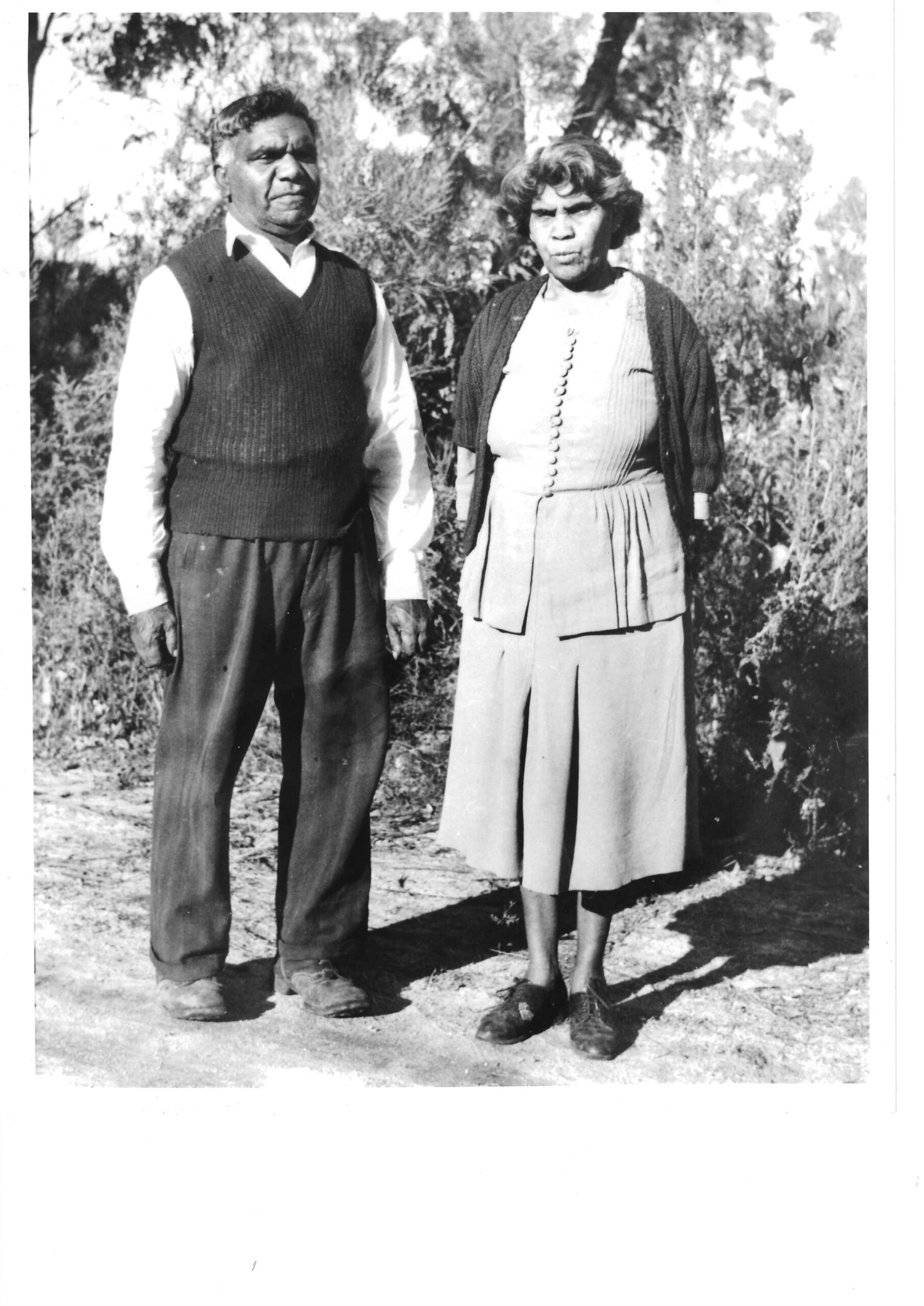Dorothy Hood nee Harrison

Born December 1895, Lake Bolac; Died March 4, 1967, Melbourne
Dora Hood was a lovely looking, gracious woman who commanded great respect among her community.
Think about her life: relocated many times, living in a community of bark huts with dirt floors and few windows, no services like water or electricity, no transport and miles out of town!
A Wotjabaluk (Wergaia)[1] woman, after losing her first husband, Dora and her children relocated several times, eventually to the Lake Tyers Mission where she met and married Kurnai man, Stewart Hood. Marrying into the Kurnai culture meant Dora could no longer speak her language or practice her culture: she fully embraced and practised the Kurnai ways.
Stewart fetched Dora and family from Lake Tyers to live in his good-sized, handmade bark hut along the Labertouche Creek at the Jackson’s Track end of the Tonkin family property.[2] A thriving community sprang up around them, close to timber-felling work.
At the centre of it, Dora laid down the rules, supported and taught the women how to prevent their families from being “taken” by White authorities by maintaining high standards of cleanliness across the community, while at the same time respecting traditional culture and the environment.
Having embraced Christianity, she was known as a bit of a Bible-basher, the Bible giving Dora a tangible and “approved code to live by to keep her family safe and together”. [3]
Dora encouraged visiting church Ministers who came to the Track for services, including Pastor Doug Nicholls[4], and in 1959, caught the train to Melbourne the Billy Graham Christian Crusade.
Ever-watchful Dora’s leadership and strict standards laid the foundation on which the Jackson’s Track community survived for decades.
This Biography was written by Jeannie Haughton in consultation with Aunty Cheryl Drayton – Kurnai Matriarch and descendant of Dorothy Hood.
Photograph: Left to Right – Stewart Hood and Dorothy Hood – Jacksons Track supplied by Aunty Cheryl Drayton
Film: Jackson’s Track — CheekyMac Productions
Commemoration: Three Kurnai Women
Three Kurnai Women is a life-size bronze sculpture celebrating the leadership of three Kurnai women. This significant public artwork, unveiled on May 27 – Reconciliation Week 2023 stands proudly on Kurnai Country in Drouin’s Civic Park.
Three Kurnai Women is the first artwork in the area solely dedicated to honouring First Nations women and pays homage to Dorothy Hood, Regina Rose, and Euphemia Mullet, who displayed leadership, wisdom, tenacity and cultural integrity to protect their families, wider community, and their Kurnai Culture in the face of historic and racial discrimination.
Each woman holds an object: a book, a laundry tub, a guitar. Selected by Kurnai Elder Cheryl Drayton – Euphemia Mullet Tonkin’s daughter – these objects represent the struggles they faced as Aboriginal people and the constant endeavor of keeping their families safe and together. The artwork depicts the three women intertwined, anchored to country and to each other.
Three Kurnai Women is a shining example of female artists working together to bring sculptures of women and their stories into public places. The sculpture was designed by local artists Jessie McLennan and Rebecca Vandyk-Hamilton, working in close consultation with Kurnai Elder Cheryl Drayton. They prepared the concept designs, sketches and clay maquettes. Meridian Sculpture foundry in Melbourne then created a full-size 3D model.
Lynette (Grace) Hayes, Regina Rose’s daughter, created the frieze border for the artwork which incorporates Kurnai symbols such as the blue wren.The piece is accompanied by oral recordings and written historical storytelling by Kurnai Elder Cheryl Drayton and local writer Jeannie Haughton.The stories can be accessed by scanning Finding Her QR codes at the base of the sculpture and by visiting the stories of Drouin website.
Three Kurnai Women was proudly supported by the Victorian Government’s Victorian Women’s Public Art Program and by Baw Baw Shire Council This significant public artwork stands to remind local residents and visitors of the very recent history of the First Nations’ families who lived and worked for decades at Jackson’s Track in Labertouche, until they were forcibly relocated to Drouin.
Site: Civic Park Drouin
Drouin Civic Park is a picturesque park located in the centre of town. The Three Kurnai Women sculpture has pride of place, signifying a physical place and prompt to discover the stories and incredible contributions of First Nations Women on Jackson’s track.
This family friendly site also includes a playground, a skate park, a small lake, shelters, cycle and pedestrian trail and car parking. This park is easily accessible by public transport.
[1] Dimboola area
[2] Jackson’s Track: Memoir of a Dreamtime Place; Tonkin & Landon 1999, Penguin Books
[3] Lynette Hayes, granddaughter of Dorothy Hood, Interview 2022
[4] Sir Douglas Ralph Nicholls KCVO; OBE; pioneering campaigner for reconciliation

